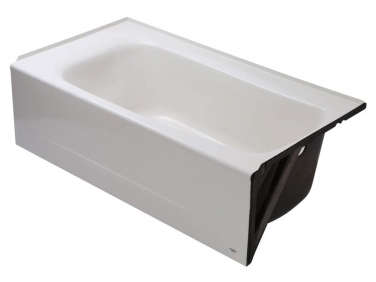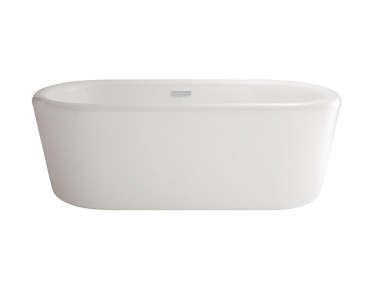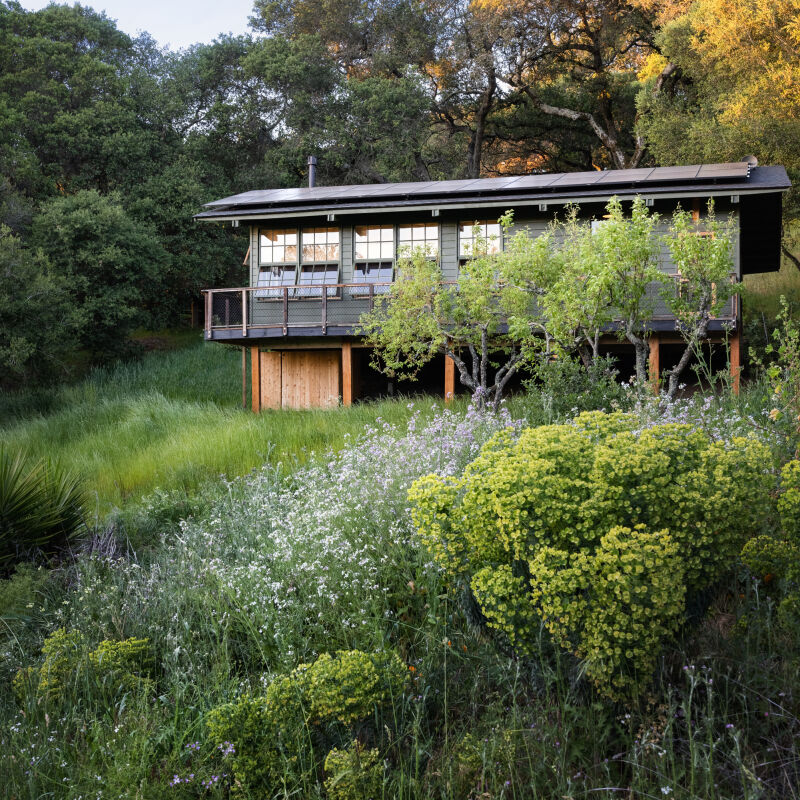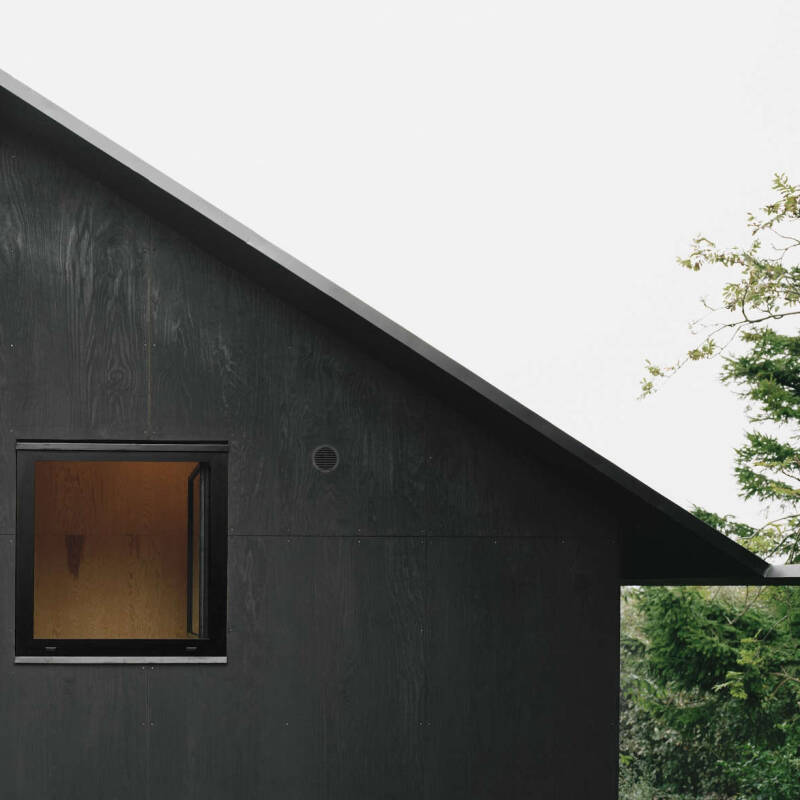Freestanding baths have long been prized as the ultimate romantic statement: The big claw-foot tubs of yore can hold two people at once (cue the scented candles and bath oil). But we’ve heard some complaints: They’re harder to clean around, and they don’t keep the bathwater hot for very long. Then again, the other option—built-in baths—gets a bad rap for being dated and less than luxurious. We did a little research—and consulted with Barbara Sallick, cofounder and senior vice president of design for kitchen and bath brand Waterworks—on the pros and cons of each.

What’s the difference between a freestanding bath and a built-in bath?
When it comes to baths, there are two basic types to consider: a built-in bath, generally installed in an alcove with walls on three sides, or a freestanding bath, which gives you more options as to where it’s placed in the room (although most freestanding tubs are installed close to a wall—and to existing plumbing). One of the more famous freestanding options is the claw-foot tub, which stands on four feet, as opposed to some contemporary freestanding tubs that sit flush on the ground or on a pedestal. (Traditionally, claw-foot baths had a Victorian-style ball and claw design, but today any tub on feet is often called a claw-foot.)
Both freestanding and built-in tubs come in a wide range of dimensions—length, width, and depth—and if you like taking baths you’ll want a tub that fits your body, so it’s a good idea to test-drive tubs in the showroom by actually climbing in and lying down.

Why would I want a built-in bath?
The answer is simple: when you’re planning to take more showers than baths, a built-in works best. It’s possible to set up a shower in a freestanding tub, but to keep water off the floor you have to suspend a shower rod and circle the tub with curtains. If you’ve ever showered that way, you know how annoying it is when a wet shower curtain encroaches on your space (and in an old, narrow freestanding tub, that’s a likely scenario). Since a built-in is usually enclosed on three sides, it’s easy to keep the water contained. (And you can often dispense with the shower curtain altogether, installing a glass partition and door alongside the tub.)
A built-in tub also takes up less space in the room and has a ledge for keeping bath products within easy reach.

Why would I want a freestanding bath?
There’s no situation that mandates a freestanding tub—most people choose freestanding baths to make a statement, or for a vintage look. If it’s style you’re after, Sallick notes that you’ll find a wider array of choices in freestanding models as well.
That said, there’s more leeway as to where the tub is positioned—as long as plumbing is adjacent. If you’d love to gaze outside while you soak, perhaps you can place your tub with a window view.

Which option is more relaxing?
Freestanding baths have a reputation for being more luxurious, perhaps because older freestanding tubs, often called soaker tubs, tended to be long and deep so bathers could easily immerse themselves in the water. Now, it’s easy to find both freestanding and built-in tubs that are long and deep, so there’s no reason to think of a claw-foot tub as being more luxurious.
Tip: If you’re planning on bathing à deux, get a tub with the faucets and overflow in the middle, rather than at the end, so you can both recline comfortably (with nothing digging into your backs) as you gaze into each other’s eyes.
Is a freestanding tub heavier than a built-in bath?
Your bathroom floor must be strong enough to support not just the weight of the tub you choose, but the weight when it’s filled with water and has someone sitting inside. But it’s more a matter of material than freestanding vs. built-in: Most modern tubs are made of either acrylic or cast iron with a porcelain finish, and a cast iron tub, whether it’s built-in or freestanding, new or vintage, will always be heavier than an acrylic tub. Fortunately, “this isn’t an issue in most homes,” Sallick says. “But if your house is old and rickety and you’re planning to put in a big cast iron tub, you might want to consult a plumber or engineer to be sure.” (The solution could involve reinforcing the floor underneath.)

Does a freestanding tub lose heat faster than a built-in?
Some say that the bathwater in a freestanding tub will cool faster, since it’s surrounded by air. If you want to ensure long, hot baths, consider a built-in, where the insulation added to the wall behind it will keep the water warm even longer, or an acrylic model, which will hold the heat longer than cast iron. Either way, it’s easy enough to run a little more hot water if you want to linger.

Is a built-in tub easier to clean than a freestanding tub?
One consideration you may not have thought of: Many find it far easier to mop or clean the floors around a built-in bath, rather than navigating around (and under) a claw-foot bath.

Can I swap my freestanding tub for a built-in, and vice versa?
It depends where you’re putting it. Any tub requires the same basic plumbing: a water source (faucets can be mounted on the wall or on a deck beside a built-in tub), a drain, and, in most tubs, an overflow to prevent flooding if you leave the water running. But a freestanding tub might need plumbing lines coming up through the floor. If you want to switch from one to the other, consult a plumber to see what’s feasible.
Something else to keep in mind, particularly if you have an old home (and old flooring): It may be easier to accommodate uneven or sloping floors with a built-in bath (which can be cut accordingly) than with a freestanding bath.

Which is more expensive: freestanding or built-in?
Generally speaking, freestanding baths tend to be pricier. Because built-in tubs usually have only one finished exterior side, they tend to be less expensive: For example, a Cambridge 5-Foot Built-In Bath by American Standard bath is less than $668.85 at Home Depot, while their Kipling Ovale Freestanding Flatbottom Bath retails for $1,671.15. Plumbing installation costs are similar for both types of baths, but note that the tile surround and a glass shower door (should you choose to install one) will add to the cost of the built-in bath.

What’s the best solution?
Having a separate shower stall is ideal, according to Barbara Sallick: “That way, you can choose between freestanding and built-in tub without having to worry about the showering issue.”
Weighing the pros and cons of design decisions in the bath? See our Bathroom Guides for insight throughout your renovation. And for more on bathtubs, see:
- 10 Easy Pieces: Silver Finish Freestanding Bathtubs
- 10 Favorites: Japanese-Style Bathtubs Around the World
- Before/After: A Perfectionist’s $1,000 Bathroom Overhaul in Brooklyn
Finally, get more ideas on how to evaluate and choose a bathtub or shower in our Remodeling 101 Guide: Bathroom Tubs & Showers.
Frequently asked questions
What is the difference between a built-in and a freestanding bathtub?
A built-in bathtub is integrated into the bathroom structure and typically surrounded by walls or an enclosure. It is fixed in place and requires installation against a wall. On the other hand, a freestanding bathtub is not attached to any walls and can be placed anywhere in the bathroom. It stands on its own and often serves as a focal point.
What are the pros of a built-in bathtub?
Built-in bathtubs offer several advantages. They can maximize space efficiency as they fit snugly against the walls, making them suitable for smaller bathrooms. Built-in tubs also provide an opportunity for storage or shelving around the tub area. Additionally, they can be designed to seamlessly blend with the overall bathroom aesthetics.
What are the pros of a freestanding bathtub?
Freestanding bathtubs have become popular for their aesthetic appeal and versatility. They create a striking visual impact and can serve as a centerpiece in the bathroom. Freestanding tubs offer more design flexibility, allowing for various styles, shapes, and materials. They also provide easier access for cleaning and maintenance.
Which type of bathtub is easier to install, built-in or freestanding?
Built-in bathtubs generally require more complex installation compared to freestanding tubs. Built-in tubs need to be properly fitted against the walls, and the surrounding enclosure or tilework requires careful installation. Freestanding tubs, on the other hand, are relatively easier to install since they don't require wall attachment or specific structural modifications.
Can both built-in and freestanding bathtubs be used in small bathrooms?
While built-in bathtubs are often preferred for smaller bathrooms due to their space-saving design, freestanding bathtubs can also be used in small spaces. The key is to choose a compact freestanding tub that fits the available space without overwhelming the room. Additionally, opting for a tub with a narrower width can help conserve space.
Are built-in or freestanding bathtubs more expensive?
The cost of built-in and freestanding bathtubs can vary depending on factors such as materials, design complexity, and brand. Generally, freestanding tubs tend to be more expensive due to their premium design, craftsmanship, and the need for all sides to be finished. However, there are affordable options available for both types, depending on the specific models and materials chosen.
Can I change a built-in bathtub to a freestanding one or vice versa?
Converting a built-in bathtub to a freestanding one or vice versa can be a complex and costly process. It often involves significant structural modifications, including plumbing reconfigurations, flooring adjustments, and potentially moving or adding support structures. It's best to consult with a professional contractor to assess the feasibility and cost of such conversions.







Have a Question or Comment About This Post?
Join the conversation